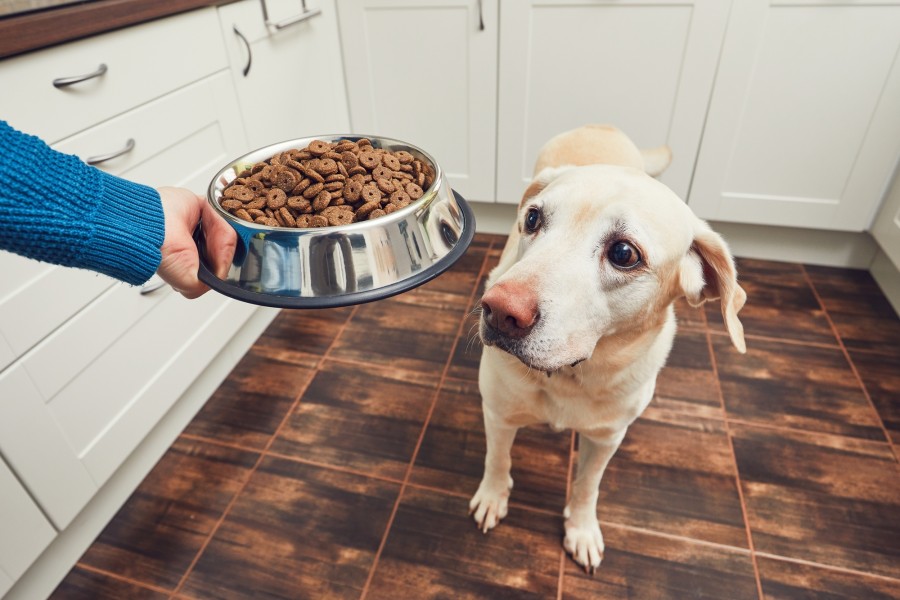Are You Feeding Your Dog the Amount it Says On the Dog Food Bag?

Are You Feeding Your Dog the Amount it Says On the Dog Food Bag? Then You Are Most Likely Feeding Your Dog the WRONG Amount of Food!
How many of us read the suggested serving sizes on the meals we prepare for our family and strictly follow them? We don’t even read the suggested serving size, unless it’s to see how much food will be made. Then, instead of going off that, we sit there, holding the package, trying to think about how much each person in our family will eat, so you know if one package is enough, too much, or not enough.
So why do we read the serving size on the back of the dog food packet as gospel? Remember, that it is a guideline made for the “average” idea of a dog. This is so we have a ball park starting amount and so we don’t give the dog a human size serving.
If you think humans vary in size, shape and amount of food they can consume without getting overweight (dang those rail-thin people who can eat anything!) The dog world has even MORE variety. From teeny-tiny teacup Chihuahuas to English Mastiffs – and everything in between. Then, within that division you have
· The teacup Chihuahua that is 13-years-old+ that’s going blind and sleeps all day.
· The teacup Chihuahua that’s 4-years-old, does agility and competitive obedience, and maybe even shows in conformation.
· The teacup Chihuahua puppy, 8-weeks-old, that’s growing every day.
· The teacup Chihuahua that’s 2-years-old, lives indoor with a family, but gets moderate exercise.
The combinations of age, exercise level and health are almost endless. Does it make sense that each one of these dogs would get the same amount of food just because they are in the same weight range? Chances are the 13-year-old would be too fat, the 4-year-old would be too thin, and the puppy wouldn’t be get enough nutrients. Perhaps the 2-year-old is doing okay, for now.

THE POINT IS YOU NEED TO TAKE INTO CONSIDERATION YOUR DOG’S AGE, HEALTH, AND ACTIVITY LEVEL, THEN ADJUST HIS MEAL SIZE ACCORDINGLY.
So how do you do this?
Luckily, it’s really not too hard to manage your dog’s food intake to keep him at the optimum weight. Optimum body score includes being able to see a few (2-3 ribs), with a defined waist that “tucks up” at the hips. There is some slight variations between breeds, but not enough to make a huge difference.
Start with where your dog is now. Is he too fat, too thin? Get his weight and look at his body condition. Compare it to the body condition score guide. If he is on either end of the spectrum – too thin or too fat – you need to adjust his food.
This means that, for example if your dog should be around 25kg, but is actually 30kg, you will need to feed him at the 20kg amount to lose that extra 5kg – and don’t forget to exercise him! Just like people, you need to combine diet and exercise to lose weight effectively and gain that important muscle tone.
But, don’t get stuck on those feeding guidelines!
Maybe your dog has an extremely slow metabolism, in which case you might need to feed even less at first to get that weight off, and then build it up to a maintenance amount that, for your dog, is still lower than what the bag says. (This is always true for desexed dogs)
Then, keep checking his condition and changing the amount you feed to match. Because it will change as your dog ages and if health issues develop. For example, a dog that develops diabetes may get really fat, and need to be on a very controlled diet, whereas a dog with thyroid issues tends to get very thin and may need to eat much more than they previously did.
You will also have to adjust your dog’s food intake if he suddenly gets more active (you start doing agility) or gets less active (an injury makes him unable to go for those 5km daily runs).
Climate can sometimes have an effect as well. We all burn more calories in the winter keeping our body warm, so dogs in very cold climates may need more calories to stay at a healthy weight, especially if they are outside in the elements a lot.
Hot weather can affect dogs food intake as well, however the important thing here is the leaner they are the more comfortable they will be in the hot weather.
The most important thing to remember is that each dog is an individual and you just need to compare your dog to the body score sheet and then adjust his meals to get him where he needs to be. Trust us, your dog will be much happier, healthier, and most likely live longer, when he is the correct body condition/weight!

The vet said that my American Staffordshire Terrier is an ideal weight. I feed significantly less kibble than it says on the bag because he is 15 yrs old and sleeps most of the day. He still has 2 walks a day of about half a kilometre each walk. Also he gets small amounts of other food like raw meaty bones, fish, meat and some fruit and vegetables.